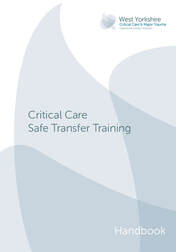Critical Care Transfers
It is vital that critically ill or injured patients are treated rapidly in an acute hospital in order to stabilise them or limit their injuries. However, there are several instances when such management may be followed by further (secondary) transfer to another acute hospital:
- Clinical transfer– when the facilities needed for definitive treatment are not available at the initial hospital.
- Capacity transfer– when the initial hospital has inadequate equipment, bed capacity, staffing or monitoring to provide the necessary care.
- Repatriation–highly specialised hospitals may need to transfer patients to ensure they can treat the next patient who needs their specialist facilities. Patients may also be moved back to hospitals nearer to their home and family. In these cases, patients will have had their specialist treatment, are almost always stable and the transfer may involve a step-down in the level of their care.
Critical Care Safe Transfer TrainingTransfer Training dates for 2024
Thursday 14th November The Training will be held at St James University Hospital in Chancellor Wing, 08:15 - 16:30. The course is open to nurses, doctors, ACCP's, ODP's working in West Yorkshire Critical Care Network Trusts who are expected to undertake critical care transfers as part of their role. Support from Clinical Educators and Supervisors is required. To register use the QR code below West Yorkshire Critical Care Transfer Training Handbook
|
WYCCODN Critical Care Transfer GuidanceYorkshire Ambulance Service Inter Facility Transfers (IFT) (May 2024)
WYCCN Transfer Handover Document WYCCN Transfer information Leaflet for Relatives / Carers The Intra Hospital Transfer Form can be downloaded and printed from the above file.
For additional A3 Inter Hospital Transfer Forms please contact [email protected] who will happily send some to you. Intensive Care Society Guidelines
Guidelines for the transport of the critically ill adult (2019) Guidance for the repatriation of critically ill patients from international hospitals to UK critical care units. ICS Guidance : Transfer Outdoors during End of Life ICS Guidance : Transfer to the Outdoors Association of Anaesthetists : Safe Transfer of the Brain Injured patient: trauma and Stroke 2019 |

